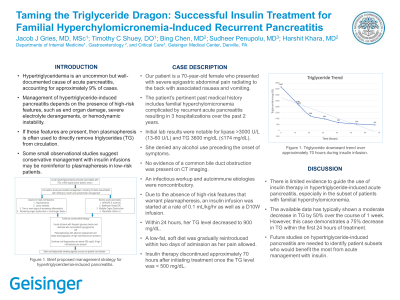Tuesday Poster Session
Category: Biliary/Pancreas
P2933 - Taming the Triglyceride Dragon: Rapid Triglyceride Correction with Insulin Treatment in Familial Hyperchylomicronemia-Induced Pancreatitis
Tuesday, October 24, 2023
10:30 AM - 4:00 PM PT
Location: Exhibit Hall

Has Audio
- JG
Jacob J. Gries, MD, MSc
Geisinger Medical Center
Danville, PA
Presenting Author(s)
Jacob J.. Gries, MD, MSc1, Timothy C. Shuey, DO1, Harshit S. Khara, MD1, Sudheer Penupolu, MD2, Bing Chen, MD1
1Geisinger Medical Center, Danville, PA; 2Geisinger, Danville, PA
Introduction: Hypertriglyceridemia is an uncommon but well-documented cause of acute pancreatitis, accounting for approximately 9% of cases. Management of hypertriglyceride-induced pancreatitis depends on the presence of high-risk features, such as end organ damage, severe electrolyte derangements, or hemodynamic instability. If these features are present, then plasmapheresis is often used to directly remove triglycerides (TG) from circulation. Some small observational studies suggest conservative management with insulin infusions may be noninferior to plasmapheresis in low-risk patients.
Case Description/Methods: Our patient is a 70-year-old female who presented with severe epigastric abdominal pain radiating to the back with associated nausea and vomiting. The patient’s pertinent past medical history includes familial hyperchylomicronemia complicated by recurrent acute pancreatitis resulting in 3 hospitalizations over the past 2 years. Initial lab results were notable for lipase >3000 U/L (13-60 U/L) and TG 3600 mg/dL (≤174 mg/dL). She denied any alcohol use preceding the onset of symptoms. No evidence of a common bile duct obstruction was present on CT imaging. An infectious workup and autoimmune etiologies were noncontributory. Due to the absence of high-risk features that warrant plasmapheresis, an insulin infusion was started at a rate of 0.1 mL/kg/hr as well as a D10W infusion. Within 24 hours, her TG level decreased to 900 mg/dL. A low-fat, soft diet was gradually reintroduced within two days of admission as her pain allowed. Insulin therapy discontinued approximately 60 hours after initiating treatment once the TG level was < 500 mg/dL.
Discussion: There is limited evidence to guide the use of insulin therapy in hypertriglyceride-induced acute pancreatitis, especially in the subset of patients with familial hyperchylomicronemia. The available data has typically shown a moderate decrease in TG by 50% over the course of 1 week. However, this case demonstrates a 75% decrease in TG within the first 24 hours of treatment. Future studies on hypertriglyceride-induced pancreatitis are needed to identify patient subsets who would benefit the most from acute management with insulin.
Disclosures:
Jacob J.. Gries, MD, MSc1, Timothy C. Shuey, DO1, Harshit S. Khara, MD1, Sudheer Penupolu, MD2, Bing Chen, MD1. P2933 - Taming the Triglyceride Dragon: Rapid Triglyceride Correction with Insulin Treatment in Familial Hyperchylomicronemia-Induced Pancreatitis, ACG 2023 Annual Scientific Meeting Abstracts. Vancouver, BC, Canada: American College of Gastroenterology.
1Geisinger Medical Center, Danville, PA; 2Geisinger, Danville, PA
Introduction: Hypertriglyceridemia is an uncommon but well-documented cause of acute pancreatitis, accounting for approximately 9% of cases. Management of hypertriglyceride-induced pancreatitis depends on the presence of high-risk features, such as end organ damage, severe electrolyte derangements, or hemodynamic instability. If these features are present, then plasmapheresis is often used to directly remove triglycerides (TG) from circulation. Some small observational studies suggest conservative management with insulin infusions may be noninferior to plasmapheresis in low-risk patients.
Case Description/Methods: Our patient is a 70-year-old female who presented with severe epigastric abdominal pain radiating to the back with associated nausea and vomiting. The patient’s pertinent past medical history includes familial hyperchylomicronemia complicated by recurrent acute pancreatitis resulting in 3 hospitalizations over the past 2 years. Initial lab results were notable for lipase >3000 U/L (13-60 U/L) and TG 3600 mg/dL (≤174 mg/dL). She denied any alcohol use preceding the onset of symptoms. No evidence of a common bile duct obstruction was present on CT imaging. An infectious workup and autoimmune etiologies were noncontributory. Due to the absence of high-risk features that warrant plasmapheresis, an insulin infusion was started at a rate of 0.1 mL/kg/hr as well as a D10W infusion. Within 24 hours, her TG level decreased to 900 mg/dL. A low-fat, soft diet was gradually reintroduced within two days of admission as her pain allowed. Insulin therapy discontinued approximately 60 hours after initiating treatment once the TG level was < 500 mg/dL.
Discussion: There is limited evidence to guide the use of insulin therapy in hypertriglyceride-induced acute pancreatitis, especially in the subset of patients with familial hyperchylomicronemia. The available data has typically shown a moderate decrease in TG by 50% over the course of 1 week. However, this case demonstrates a 75% decrease in TG within the first 24 hours of treatment. Future studies on hypertriglyceride-induced pancreatitis are needed to identify patient subsets who would benefit the most from acute management with insulin.
Disclosures:
Jacob Gries indicated no relevant financial relationships.
Timothy Shuey indicated no relevant financial relationships.
Harshit Khara: Boston Scientific – Consultant, Speakers Bureau. Castle Biosciences – Consultant, Speakers Bureau. ConMed – Consultant, Speakers Bureau. Cook Medical – Consultant, Speakers Bureau. Medtronic – Consultant, Speakers Bureau. Olympus America – Consultant, Speakers Bureau. Pentax – Consultant, Speakers Bureau.
Sudheer Penupolu indicated no relevant financial relationships.
Bing Chen indicated no relevant financial relationships.
Jacob J.. Gries, MD, MSc1, Timothy C. Shuey, DO1, Harshit S. Khara, MD1, Sudheer Penupolu, MD2, Bing Chen, MD1. P2933 - Taming the Triglyceride Dragon: Rapid Triglyceride Correction with Insulin Treatment in Familial Hyperchylomicronemia-Induced Pancreatitis, ACG 2023 Annual Scientific Meeting Abstracts. Vancouver, BC, Canada: American College of Gastroenterology.
